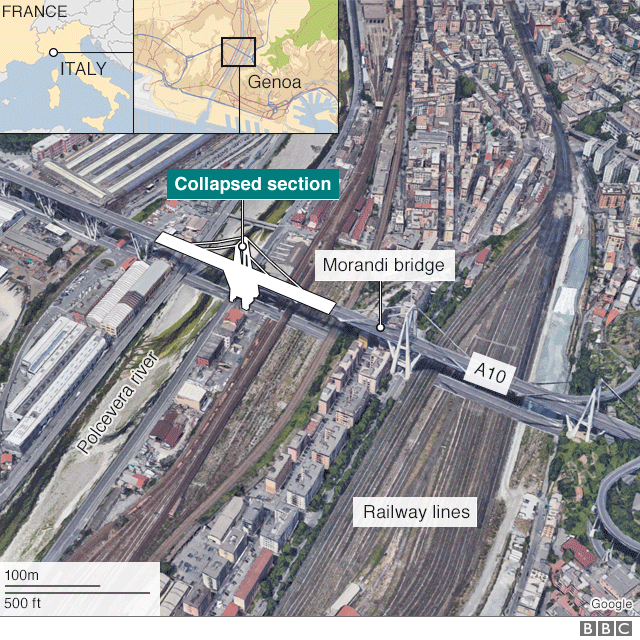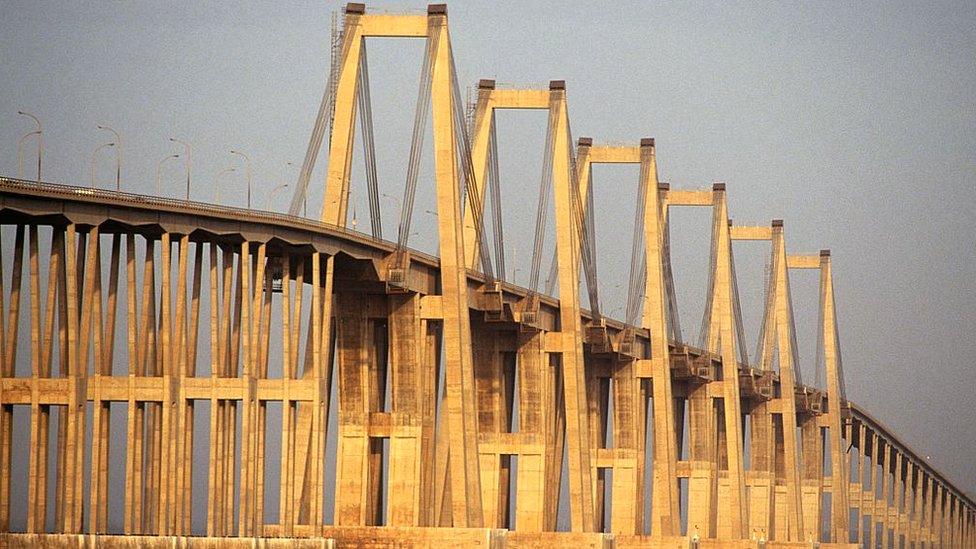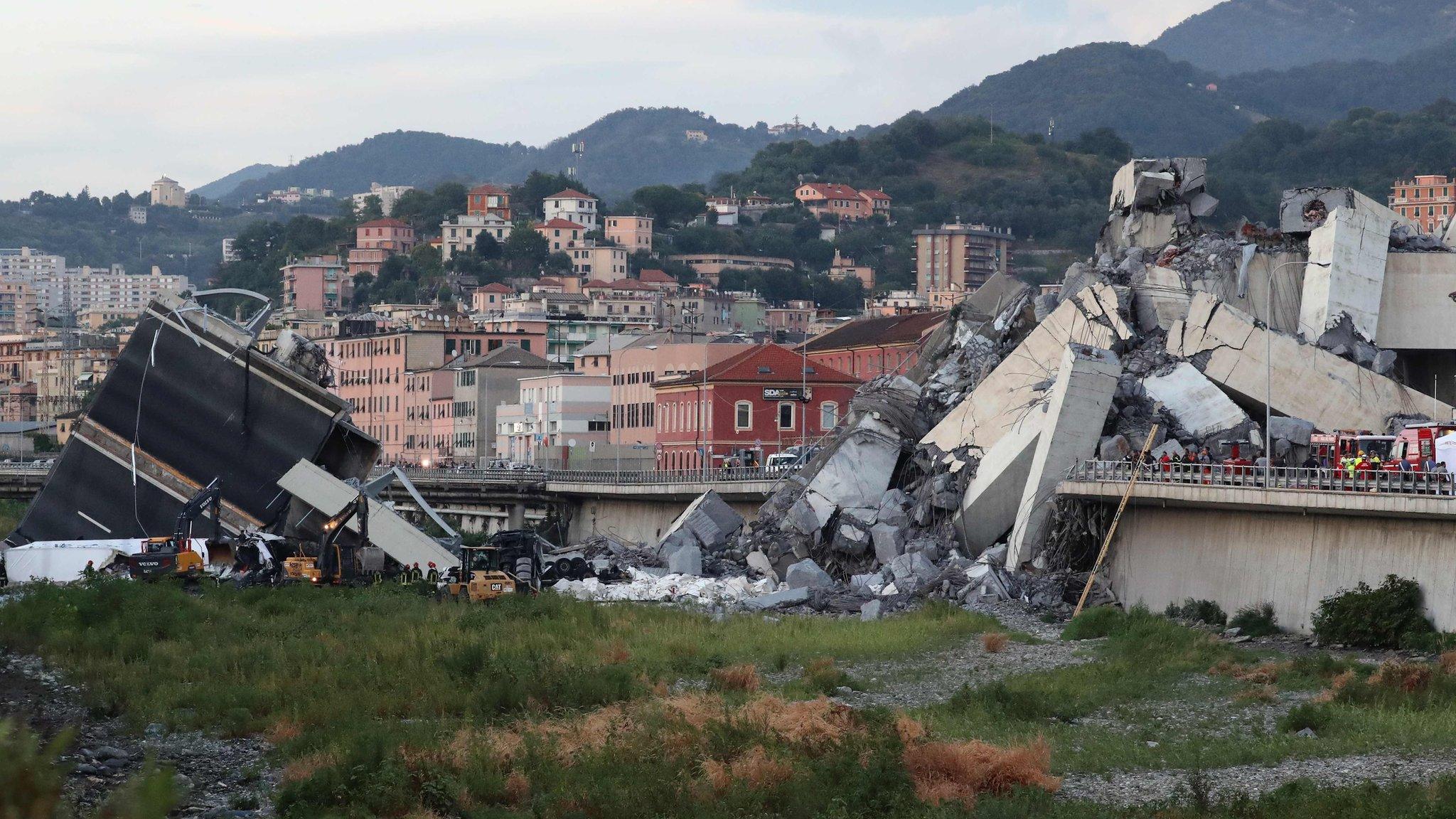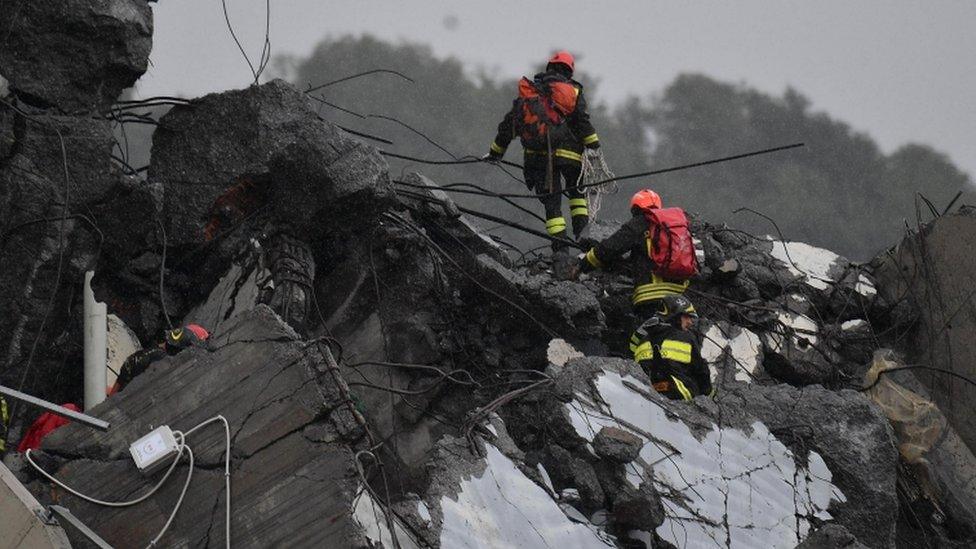Italy bridge collapse: What might have caused it?
- Published
Parts of the bridge can be seen collapsing
It is not yet clear what caused the collapse of the Morandi bridge in the Italian city of Genoa, but several explanations have been mooted.
At least 39 people were killed when part of the bridge, and cars travelling along it, fell 45m (148ft).
Structural engineers who spoke to the BBC said there were some clear avenues investigators should explore, but warned no firm conclusions could yet be reached.
Factor one: Wear and tear?
The Morandi bridge was completed in 1967, and normally a bridge is designed to last for at least 100 years.
But Stergios Mitoulis, a senior lecturer at the University of Surrey specialising in bridge design, said some environmental factors may have caused this bridge to deteriorate early.
"One factor could be the proximity to the sea, and the second could be the fact that the bridge was in an industrial area, so the local pollutants could have led to an accelerated decline."
Mr Mitoulis highlighted an area of concern in parts of the bridge that are still standing. Rust can be seen at the top of the tendons - the "arms" extending from the top of the bridge that sustain the weight of the road underneath.

"From what I have seen," he said, "it is quite obvious that they have deteriorated. Failure of one of those components is like cutting off one's leg and then expecting to be able to sustain the same load on just one leg."
Italy's two deputy prime ministers have criticised motorway operator Autostrade per l'Italia, who were in charge of the bridge. "Autostrade should have done maintenance and didn't do it," one of the ministers, Luigi Di Maio, said.
But the company said it had been carrying out regular maintenance checks on the bridge and was satisfied by the results of "companies and institutions which are world leaders in testing and inspections".
Restructuring work was also carried out on the bridge in 2016.
"A major bridge like this needs regular inspection and maintenance by qualified engineers. This bridge has had quite a lot of maintenance work," said Ian Firth, a former president of the UK-based Institution of Structural Engineers, and a structural engineer specialising in bridges.
"In the sad history of bridge collapses, maintenance has sometimes been a factor, if it is poorly planned or implemented."
In December 2012, Genoa's city council discussed the state of the bridge at a public hearing into how to expand the local transport infrastructure. An industry confederation official warned of the collapse of the Morandi bridge "in 10 years".

Factor two: Design flaws?
Mr Mitoulis said it was very unusual to see only four tendons supporting the weight of the bridge's deck in each section, when any bridges being built in 2018 would have up to 10 times as many.
The tendons on the Morandi bridge are also, unusually, made of reinforced concrete. The material contains steel, which rusts, and is prone to weakening over time.
"At that time, when the designer chose these tendons, he was not aware of its potential for failure," Mr Mitoulis said.
Work on reinforcing the tendons with steel was carried out in the 1990s.
Antonio Brencich, a structural engineer who lectures at Genoa University, wrote in 2016 that the designer, Riccardo Morandi, had miscalculated how reinforced concrete aged. "He was an engineer with great insight, but lacking in practical calculations."
The bridge's ongoing maintenance costs meant it might have been more economical to rebuild it, he wrote.
"Right away, the bridge manifested various problems, beyond the construction costs, which went over budget.
"There are errors in this bridge, external. Sooner or later, it will have to be replaced. I don't know when," he warned.

General Rafael Urdaneta Bridge on Lake Maracaibo in Venezuela was also designed by Riccardo Morandi
The Morandi bridge is very similar to its much larger cousin, the Lake Maracaibo bridge in Venezuela, which was also designed by Mr Morandi.
That bridge "has also experienced problems during its life, so it could be that the design implies a need for a greater degree of maintenance than normal", said Ian Firth.
But he added: "As yet, there is no evidence to say whether any impact occurred; it is too early to say what triggered the collapse."
Factor three: Heavy traffic?
The degradation may have also been compounded by heavy traffic on the bridge, over which about 25 million vehicles passed every year. It carries a major artery, the A10, that serves the Italian Riviera and links northern Italy to France.
A 2011 report by Autostrade per l'Italia said heavy traffic had taken its toll on the bridge.
The "queues of cars and the volume of traffic provoke intense degradation of the bridge structure on a daily basis in rush hour, as it is subject to major demands", the report, quoted by Italian news agency Ansa, said.

"The collapse could have been influenced by the consequences of increases in heavy traffic and the punishing treatment the motorway got. It was heavily used, there is no question about that," Mr Firth said.
But the bridge may have also suffered from the marked drop in investment in the country's infrastructure, which lags behind other economies in western Europe.
Engineering experts all agree that in the end, only a thorough specialist investigation will be able to determine the real causes of the collapse.
Factor four: Another problem?
The collapse took place during a storm and amid heavy winds. Separately, the motorway operator said work to shore up the bridge's foundation was being carried out at the time of the collapse, during which time it was being constantly monitored.
Italy's government has ordered an investigation, but experts warn it is too soon to focus on any one cause.
"It's easy to understand what happened - we had a loss of support," Mr Mitoulis said. "But it's hard to understand all the factors that led to that collapse."
- Published19 August 2018

- Published14 August 2018

- Published14 August 2018
